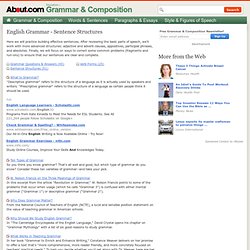

The Subordinate Clause. Printer Fabulous!

Recognize a subordinate clause when you see one. A subordinate clause—also called a dependent clause—will begin with a subordinate conjunction or a relative pronoun and will contain both a subject and a verb. This combination of words will not form a complete sentence. It will instead make a reader want additional information to finish the thought. Here is a list of subordinate conjunctions: Here are your relative pronouns: Now take a look at these examples: After Amy sneezed all over the tuna salad After = subordinate conjunction; Amy = subject; sneezed = verb. Remember this important point: A subordinate clause cannot stand alone as a sentence because it does not provide a complete thought. After Amy sneezed all over the tuna salad. Correctly attach a subordinate clause to a main clause. When you attach a subordinate clause in front of a main clause, use a comma, like this: Subordinate Clause + , + Main Clause. Main Clause + Ø + Subordinate Clause.
Rhonda gasped. Sentence Structure Tests and Worksheets - All Grades. Introduction to Sentence Combining - Sentence Combining Exercises. This exercise will introduce you to sentence combining--that is, organizing sets of short, choppy sentences into longer, more effective ones.

However, the goal of sentence combining is not to produce longer sentences but rather to develop more effective sentences--and to help you become a more versatile writer. Sentence combining calls on you to experiment with different methods of putting words together. Because there are countless ways to build sentences, your goal is not to find the one "correct" combination but to consider different arrangements before you decide which one is the most effective.
An Example of Sentence Combining Let's consider an example. She was our Latin teacher. Balanced sentence - definition and examples of balanced sentences in English. Sentence Structures. Here we will practice building effective sentences.

After reviewing the basic parts of speech, we'll work with more advanced structures: adjective and adverb clauses, appositives, participial phrases, and absolutes. Finally, we will focus on ways to correct some common problems (fragments and run-ons) to ensure that our sentences are clear and complete. What Is Grammar? "Descriptive grammar" refers to the structure of a language as it is actually used by speakers and writers. "Prescriptive grammar" refers to the structure of a language as certain people think it should be used. Ten Types of GrammarSo you think you know grammar? W. Why Does Grammar Matter? Why Should We Study English Grammar?
What Works in Teaching GrammarIn her book "Grammar to Enrich and Enhance Writing," Constance Weaver delivers on her promise to offer a text that's "more comprehensive, more reader friendly, and more concretely focused on teachers' practical needs. " What Is Sentence Combining and How Does It Work? Basic Sentence Structure. Sentence Play - Games for teaching sentence structure. How To Teach Sentence Structure: Easy Object Lesson With Zero Preparation.